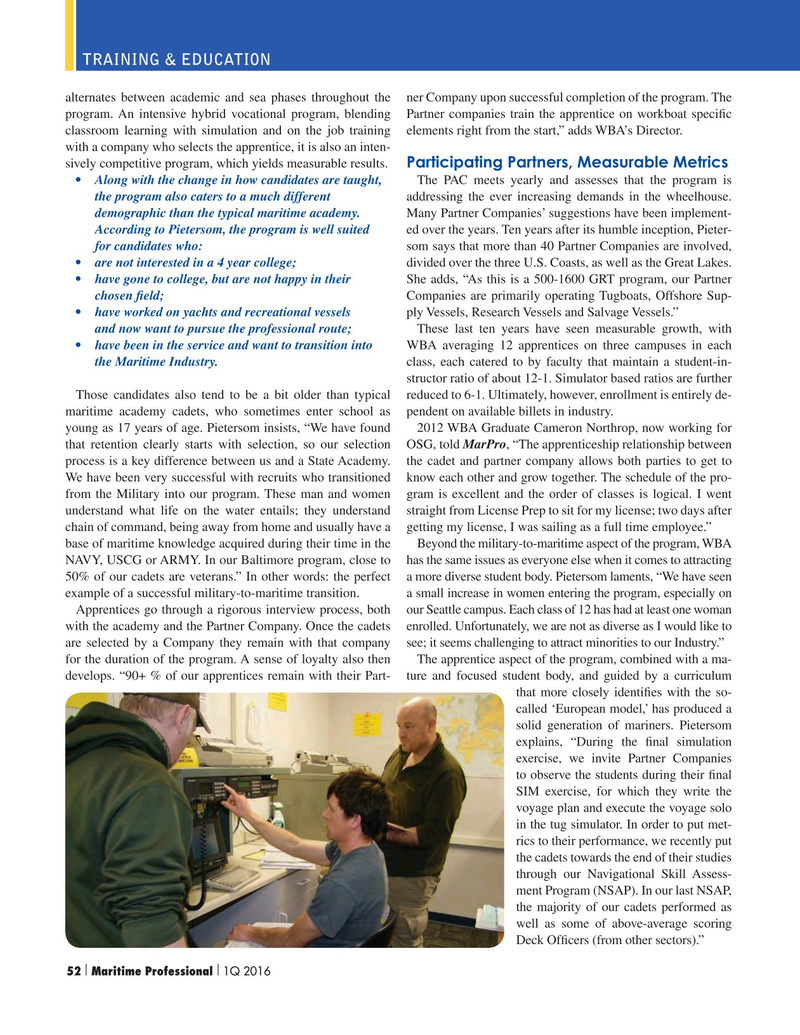
Page 52: of Maritime Logistics Professional Magazine (Q1 2016)
Maritime Training and Education
Read this page in Pdf, Flash or Html5 edition of Q1 2016 Maritime Logistics Professional Magazine
TRAINING & EDUCATION alternates between academic and sea phases throughout the ner Company upon successful completion of the program. The program. An intensive hybrid vocational program, blending Partner companies train the apprentice on workboat speci? c classroom learning with simulation and on the job training elements right from the start,” adds WBA’s Director.
with a company who selects the apprentice, it is also an inten- sively competitive program, which yields measurable results.
Participating Partners, Measurable Metrics • Along with the change in how candidates are taught, The PAC meets yearly and assesses that the program is the program also caters to a much different addressing the ever increasing demands in the wheelhouse. demographic than the typical maritime academy. Many Partner Companies’ suggestions have been implement- According to Pietersom, the program is well suited ed over the years. Ten years after its humble inception, Pieter- for candidates who: som says that more than 40 Partner Companies are involved, • are not interested in a 4 year college; divided over the three U.S. Coasts, as well as the Great Lakes. • have gone to college, but are not happy in their She adds, “As this is a 500-1600 GRT program, our Partner chosen ? eld; Companies are primarily operating Tugboats, Offshore Sup- • have worked on yachts and recreational vessels ply Vessels, Research Vessels and Salvage Vessels.” and now want to pursue the professional route; These last ten years have seen measurable growth, with • have been in the service and want to transition into WBA averaging 12 apprentices on three campuses in each the Maritime Industry. class, each catered to by faculty that maintain a student-in- structor ratio of about 12-1. Simulator based ratios are further
Those candidates also tend to be a bit older than typical reduced to 6-1. Ultimately, however, enrollment is entirely de- maritime academy cadets, who sometimes enter school as pendent on available billets in industry.
young as 17 years of age. Pietersom insists, “We have found 2012 WBA Graduate Cameron Northrop, now working for that retention clearly starts with selection, so our selection OSG, told MarPro, “The apprenticeship relationship between process is a key difference between us and a State Academy. the cadet and partner company allows both parties to get to
We have been very successful with recruits who transitioned know each other and grow together. The schedule of the pro- from the Military into our program. These man and women gram is excellent and the order of classes is logical. I went understand what life on the water entails; they understand straight from License Prep to sit for my license; two days after chain of command, being away from home and usually have a getting my license, I was sailing as a full time employee.” base of maritime knowledge acquired during their time in the Beyond the military-to-maritime aspect of the program, WBA
NAVY, USCG or ARMY. In our Baltimore program, close to has the same issues as everyone else when it comes to attracting 50% of our cadets are veterans.” In other words: the perfect a more diverse student body. Pietersom laments, “We have seen example of a successful military-to-maritime transition. a small increase in women entering the program, especially on
Apprentices go through a rigorous interview process, both our Seattle campus. Each class of 12 has had at least one woman with the academy and the Partner Company. Once the cadets enrolled. Unfortunately, we are not as diverse as I would like to are selected by a Company they remain with that company see; it seems challenging to attract minorities to our Industry.” for the duration of the program. A sense of loyalty also then The apprentice aspect of the program, combined with a ma- develops. “90+ % of our apprentices remain with their Part- ture and focused student body, and guided by a curriculum that more closely identi? es with the so- called ‘European model,’ has produced a solid generation of mariners. Pietersom explains, “During the ? nal simulation exercise, we invite Partner Companies to observe the students during their ? nal
SIM exercise, for which they write the voyage plan and execute the voyage solo in the tug simulator. In order to put met- rics to their performance, we recently put the cadets towards the end of their studies through our Navigational Skill Assess- ment Program (NSAP). In our last NSAP, the majority of our cadets performed as well as some of above-average scoring
Deck Of? cers (from other sectors).” 52 Maritime Professional 1Q 2016| | 50-63 Q1 MP2016.indd 52 2/29/2016 11:43:19 AM

 51
51

 53
53
